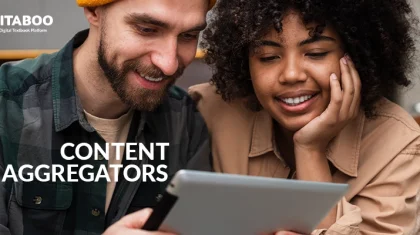
Breaking Barriers: How Digital Platforms Enhance Inclusive Education
Summarize this blog with your favorite AI:
Inclusive education is a paradigm shift in the manner students are educated, especially those who may be different or handicapped in some way. It’s based on an inclusive class where each learner is not separated according to his abilities or disability.
UNESCO promotes an inclusive and harmonious society and helps maximize every learner’s potential. It advocates for the application of digital innovation to increase access to learning opportunities, quality learning, and inclusiveness.
It stresses how digital tools will create a more balanced and accessible learning environment where all learners, regardless of their origins and backgrounds, shall have fair access to good learning conditions.
KITABOO , a leading digital textbook platform, supports a wide variety of content formats, from PDFs to videos to interactive quizzes—empowering educators to design lessons that cater to all types of learners.
Let us learn how digital learning platforms are promoting inclusive education!
Table of Contents:
I. Inclusive Education for Marginalized Learners
II. Unlocking the Power of Inclusive Education through Digital Learning Platforms
- Open Access to Quality Education for All
- Creating an Inclusive Environment
- Availability of More Resources
- Better Academic Outcomes
- Promotion of Respect and Appreciation
- Beyond Geographical Borders
- Making Education Affordable
- Promotion of Cultural Awareness and Sensitivity
- Personalized Education
III. How Digital Learning Platforms Are Securing Inclusive Education
- Universal Design for Learning
- Assistive Technologies: Bridging the Accessibility Gap
- Responsive Design Learning
- Promotes Inclusive Language and Content in Education
- Continuous Training of Educators in an Inclusive Digital Learning Environment
IV. Conclusion
Inclusive Education for Marginalized Learners
Digital learning platforms ensure that people, especially disabled, have access to and utilization of Information and Communication Technologies. Digital inclusion has a very crucial role in making education accessible to those who are left out in traditional learning environments.
Key Resources of Digital Accessibility
- Digital Libraries: The digital library provides the learner access to a vast majority of educational resources, be it textbooks or research papers, from any corner of the globe. According to a report, 90% of K12 public school teachers said that digital learning tools are best when looking for information or doing research.
- Mobile Learning: Thanks to smartphones and tablets, mobile learning has made education accessible to many students over the years. It increases learners’ engagement by 18%, motivates them by 70%, and slashes learning time by 25%-60%.
Also Check: Digital Publishing Solution for Content Aggregators
Unlocking the Power of Inclusive Education through Digital Learning Platforms
With technology at its highest peak, now has never been a better time to unlock opportunities for inclusive educational environments. Digital learning platforms influence how educational content is constructed, accessed, and consumed.
They open new avenues in achieving equal learning opportunities among students. Here are some ways in which digital learning platforms are offering inclusive education and realizing benefits:
1. Open Access to Quality Education for All
Among other objectives, inclusive education ensures that all children, rich or poor, with capabilities or otherwise, benefit from quality education.
Digital platforms such as KITABOO are critical in breaking down the barriers to education, providing learners with an engaging learning experience and varied content relevant to the learner’s needs.
2. Creating an Inclusive Environment
An inclusive environment in educational institutions, organizations, and communities results from an awareness of learner diversity and the implementation of diversified educational methods.
With proper digital learning environments, students of different cultures, languages, and learning capabilities can thrive in one environment.
3. Availability of More Resources
With digital technology advancing, the way people design and distribute educational material has changed.
eBooks, online courses, and digital libraries have presented easy, quality learning opportunities that students can enjoy, regardless of geographical or socio-economic conditions.
4. Better Academic Outcomes
In an inclusive education environment, evidence exists that students taught in such settings tend to perform better than their counterparts trained outside such settings.
They tend to exhibit better results in tests, superior cognitive skills, and higher graduation rates. Inclusive education enhances problem-solving skills through collaborative solutions to more abstract problems, which is much needed for success.
5. Promotion of Respect and Appreciation
Inclusive education has the function of reducing the stigma associated with notably disabled children or special needs. This will encourage students to live with diversity as it brings about an environment of mutual respect and understanding.
This leads to greater acceptance and inclusion of people with disabilities into school settings and beyond in society.
6. Beyond Geographical Borders
One of the biggest liberating factors of online education is that a student is freed from geographical boundaries, making quality education available to everyone across the globe.
Whether a learner lives in a busy urban center or a tiny village in a rural area, online platforms ensure that this opportunity extends to every corner.
7. Making Education Affordable
Online education is less expensive because it substitutes traditional means of conducting classes. Learners coming from socio-economic backgrounds can now afford to learn. It keeps transport, accommodation, and physical learning material costs at a minimum.
Moreover, it results in a decrease in the cost involved with higher education by approximately 70%, thus providing underprivileged students a chance to enjoy free, uninterrupted studies.
8. Promotion of Cultural Awareness and Sensitivity
Online learning settings bring in students from various ethnic and geographical origins, which can assist them in preparing a more diversified pedagogical site.
The students can be exposed to different viewpoints and ideas, hence coming out as culturally aware and sensitive with the finest skills needed to work in the globalized world.
9. Personalized Education
One of the biggest impacts of digital learning platforms promoting inclusive education is the potential to provide customized learning opportunities. Digital tools can personalize learning, customizing it based on what learners need.
Assistive technologies such as text-to-speech software, screen readers, and interactive learning modules help students with disabilities access the same content in a better-suited format to their abilities.
How Digital Learning Platforms Are Securing Inclusive Education
The global market for online education is expected to grow significantly, reaching $185.20 billion by the end of 2024. This market is assumed to undergo a CAGR of 8.56% from 2024 to 2029.
This rapid growth can be seen as an increased reliance on digital platforms to provide educational solutions for an ever-growing audience.
Here are various ways in which digital learning platforms are promoting inclusive education:
1. Universal Design for Learning
Universal design for learning is a strategic framework that considers the diverse needs of learners. It involves creating flexible learning materials incorporating multiple means of representation, engagement, and expression to ensure that all students can access content.
Here are some of its key features:
- Information is processed in varying forms—visual, textual, audio, and interactive—to meet different learner needs.
- It gives students choices to engage in learning activities and participate more positively.
- It encourages students to express thinking through a wide range of formats, such as writing and speaking, graphical projects, or digital tools.
2. Assistive Technologies: Bridging the Accessibility Gap
Some of the digital tools used by modern educational organizations to promote accessibility and inclusive education are:
- Text-to-Speech (TTS) Technology: These technologies enable students who are either visually challenged, suffer from dyslexia, or are auditory learners. They help them interact with learning content in the most effective way for them. TTS technology reads aloud any content. Speech-to-text technology converts spoken words to written text and assists students having problems with traditional reading and writing.
- Captions and Transcripts for Multimedia Components: Multimedia, including video and audio files, is an important component of modern education. Therefore, it is crucial to include captions for audio and audio components, including video files and audio files.
- Alt Text: It describes the multimedia content within the educational framework that enhances understanding of visual content.
3. Responsive Design Learning
The brilliance of digital learning platforms is that they adjust to all devices. Responsive design offered by digital learning platforms ensures that the content is accessible and user-friendly on desktops, laptops, tablets, and smartphones to accommodate students’ varied preferences.
Digital textbook platforms like KITABOO help with educational learning. It automatically adapts to different screen sizes and operating systems and is available from any device.
4. Promotes Inclusive Language and Content in Education
Inclusive education is about providing access to learning and a convenient learning environment that respects and celebrates diversity. This can be quite possible with the use of inclusive languages and content representation, including diverse cultures, perspectives, and experiences.
Here are key features:
- The educational materials should depict various cultures and perspectives to augment an inclusive and equitable approach to learning.
- There should be sensitive and inclusive use of language, avoiding terms that would stigmatize any group of learners.
5. Continuous Training of Educators in an Inclusive Digital Learning Environment
Educators have always been the heart and soul of an inclusive digital learning environment. They need to be trained to utilize accessibility tools for integrating assistive technologies and deploy more inclusive teaching practices.
Professionals should update their knowledge and skills regarding the latest research and trends in assistive technology and inclusive education methods.
KITABOO, the leading digital textbook platform, stands out within the digital movement for inclusive education because it offers educators tools to create content that they can then deliver.
With various content formats and interactive elements, KITABOO has enriched the engagement of learners with varied educational needs, so no learner is ever left behind in the digital era.
Conclusion
Digital learning platforms pioneer a shift towards inclusivity through personalized, adaptive, accessible tools that respond to the diverse needs of learners. The bottom line is that they give educators innovative solutions and support students in their pursuit to redefine what it means to have an inclusive education in modern times.
Realizing inclusive education means embracing the fact that every student, whatever their disabilities or background, should have equal access to quality education.
Digital textbook platforms like KITABOO empower the ability of educators by designing lessons based on the needs of learners.
Also check:
Discover how a mobile-first training platform can help your organization.
KITABOO is a cloud-based platform to create, deliver & track mobile-first interactive training content.


